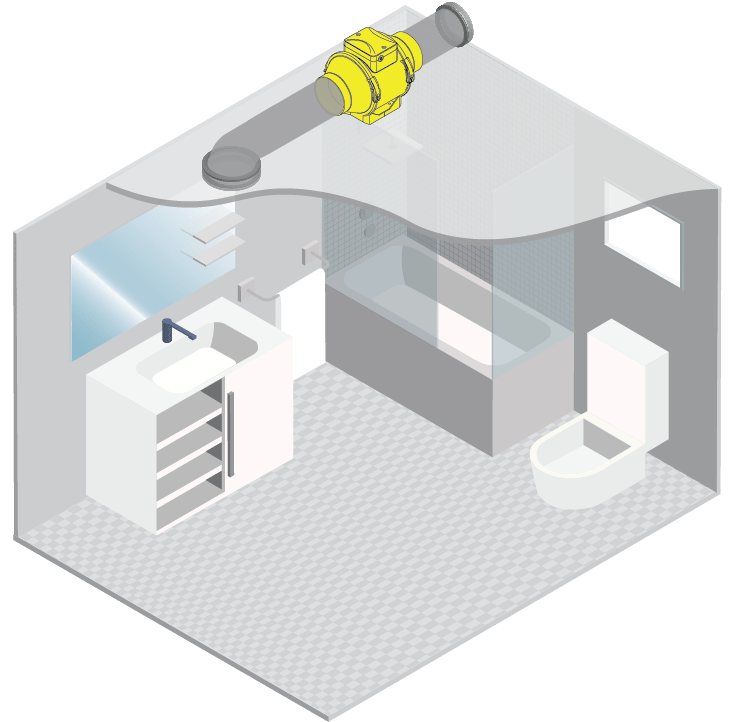Motor Type
Buyer Guides + Support
Exhaust Fans also help keep your bathroom clean and healthy by helping eliminate condensation and mould.
Ceiling Exhaust Fans expel air upwards through the ceiling and can be exhausted into the roof cavity or ducted to be exhausted outside.
The fan’s extraction rate should match the room size to achieve the recommended number of air changes. This is easy to work out with your rooms measurements and our Exhaust Calculator.
If the fan is undersized, it won’t ventilate effectively; if oversized, it can waste energy and sometimes be noisier.

Bathroom diagram with a ceiling exhaust fan
The old unit will need to be removed. Measure the existing cutout to ensure the new fan fits.
Cut a hole in the plasterboard as required by the chosen model. An electrician may be required to install an electrical switch into the roof cavity if one is not available.
Modern homes typically duct the air outside. We recommend that the duct run is as short and direct as possible to improve your fans performance.
If your home has a well-ventilated roof space, you can vent into the cavity.
Warm steam can trigger condensation and drip from the exhaust fan fascia.
There are also safety risks if IP rated fans are not installed.
If above the shower is the only installation option, we recommend installing an inline fan or roof mounted fan.
Explore our most popular Ceiling Exhaust Fans below.
Wall exhaust fans are great solutions for when space in the roof is limited.
Most wall exhaust fans have an internal motor connected to an external vent via ducting or tubing.

Bathroom diagram with a wall exhaust fan.
Fan featured is the 150 Quiet 2 Speed Fan
Remove the old fan and measure both the wall hole and wall depth before purchasing a replacement.
Ensure the unit suits your wall depth. Most exhaust fans come with a template to help you accurately mark the hole size required.
Choose between models with the motor inside the room or mounted externally. Options range from standard toilet fans to high-capacity units for larger spaces.
Explore our most popular Wall Exhaust Fans below.
Click here to view our complete range of wall exhaust fansInline fans are installed within the ceiling cavity, mounted between duct lengths. They’re ideal for areas that do not have clearance or roof space for a ceiling exhaust fan.
Inline fans are often quieter than ceiling exhaust fans or wall fans.

Bathroom diagram with an Inline exhaust fan
Fan featured is the TT Mixflow fan
Each model includes a pressure curve, specifications, and dimensions for easy comparison. If you need help determining the right fan for you, our specialist team are here to support.
Explore our most popular Inline Exhaust Fans below.
Click here to view our complete range of inline exhaust fansWindow exhaust fans are ideal for apartments and units with limited roof space.
A window fan consists of two parts that fit together through a hole in the glass, creating a weatherproof seal while exhausting air directly outdoors.
The most important factor when purchasing a window fan is the hole diameter. When replacing an existing unit, remove it first to measure the hole accurately. For new installations, a glazier is required to cut the hole in the glass.

Bathroom diagram with a window exhaust fan
Fan featured is the Valerie 150 fan
Explore our most popular Window Exhaust Fans below.
Click here to view our complete range of window exhaust fansCeiling exhaust fans are a versatile ventilation option and can be purchased as standard exhaust-only models or as 3-in-1 units combining exhaust, heat, and light functions.
These units are especially popular in bathrooms, providing heating and lighting in addition to ventilation. They are ideal for saving space and adding comfort during colder months. Heat lamps provide focused warmth directly beneath the unit.
Models are available in various capacities, finishes (commonly white and black), and configurations. Some include remote controls or additional light or heat lamp options to suit your needs.
Selecting the right replacement model depends on the hole size. Remove the existing unit and measure the opening.
For new installations, cut a hole in the plasterboard according to the fan’s specifications.

Bathroom diagram with a ceiling exhaust fan with LED light
Explore our most popular Multipurpose Units below.

If you required any further assistance please feel free to call us on 9095 6933